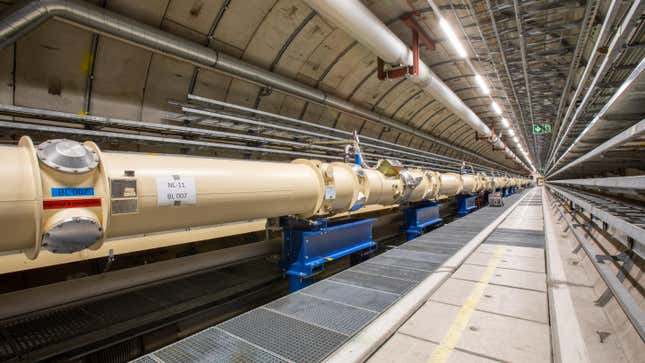
Long tubes, strong magnets, and bright lasers. Is that all it takes to entice the shyest particles in the universe to reveal themselves?
Physicists working on the ALPS II experiment certainly hope so, as they kicked off their search for axionic (or axion-like) dark matter on Tuesday, May 23. ALPS (Any Light Particle Search) is a 820-foot experiment at the Deutsches Elektronen-Synchrotron, or DESY.
ALPS II is looking for elementary particles that have as of yet eluded human observation. These particles are thought to be responsible for so-called dark matter, the catch-all term for the 27% of stuff in the universe that has not been directly observed, but whose presence is seen in dark matter haloes and gravitational lensing.
On large scales, the fingerprints of dark matter are clear, but to identify what specifically comprises the unknown stuff, physicists have to look at some of the smallest scales.
There are several primary candidates for dark matter, but the two frontrunners are Weakly Interacting Massive Particles (WIMPs) and axions. Axions are named for a laundry detergent and are smaller than WIMPs. In fact, they’re theorized to be so small that they behave more like waves than particles, similar to photons of light (another dark matter candidate, dark photons, are thought to act similarly, hence its name).
One property of axions is that they may pop in and out of existence—perhaps even from ordinary photons. The ALPS II experiment is designed to detect particles like axions by taking measurements of these potential changes, from photons to axions and back again. The magnets in the experiment, which are used to create a magnetic field to host this photon-to-axion transformation, were taken from the since-retired HERA accelerator at DESY.
ALPS II is separated into two parts by a wall that light cannot pass through, but an axion could. If light shows up on the far side of the experiment, it would indicate to scientists that a photon turned into an axion, transitted the wall, and reverted to a photon.
“Despite all our technical tricks, the probability of a photon turning into an axion and back again is very small,” said Axel Lindner, project leader at DESY and spokesperson of the ALPS collaboration, in a DESY release. The odds, Lindner added, are “like throwing 33 dice and them all coming up the same.”
The experiment will begin its search in an “attenuated operating mode,” according to the release, to make it easier to discern background light that could give false positives for axionic dark matter. ALPS II is expected to reach full sensitivity later this year and will have its mirror system upgraded next year. The first data from the experiment is expected in 2024.
“Even if we don’t find any light particles with ALPS, the experiment will shift the exclusion limits for ultra-light particles by a factor of 1000,” Lindner said. That’ll be a big step, as the axion search thus far has been a laborious process of homing in on the likely mass range for the theorized particles.
ALPS II will join forces with other behemoth dark matter detectors like LUX-ZEPLIN in South Dakota and XENON1T under the Apennine Mountains in sniffing out the elusive physics that undergird the universe.